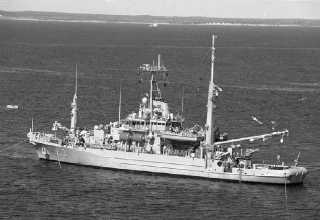auxiliaries, there is bound to be an occasional
overlapping of functions to meet an unexpected
situation.
Rescue and Salvage Ships.—The mission of the
r e s c u e
a n d
s a l va g e
s h i p
( A R S )
h a s
f o u r
parts—debeaching stranded vessels, heavy lift
capability from ocean depths, towing other vessels, and
manned diving operations. For rescue missions, these
ships are equipped with fire monitors forward and
amidships, which can deliver either fire-fighting foam
or seawater. The salvage holds of these ships are
outfitted with portable equipment to provide assistance
to other vessels in dewatering, patching, and supplying
of electrical power and other essential services required
to return a disabled ship to an operating condition.
The Navy employs ARSs (fig. 8-37) to salvage U.S.
government-owned ships and, when it is in the best
interests of the United States, privately owned vessels.
The rugged construction of these steel-hulled ships,
combined with speed and endurance, make rescue and
salvage ships well suited for rescue/salvage operations
of Navy and commercial shipping throughout the world.
The versatility of this class of ship adds to the
capabilities of the U.S. Navy with regard to assisting
those in need on the high seas.
Oceangoing Tugs.—There is one major type of
oceangoing tug—the ATF (fleet ocean tug) (fig. 8-38). It
has a large cruising range and limited salvage
capabilities. ATFs are equipped with firefighting
equipment, including fire monitors. (A fire monitor is
similar in appearance to a gun and permits water to be
discharged through a horizontal arc of 360°.) They also
are fitted with automatic towing machines and booms.
In addition to hauling and towing, fleet tugs may be
called on to patrol certain areas, lay smoke screens, and
pull landing craft off beaches. They are often used in
search and rescue (SAR) operations. Military Sealift
Command (MSC) personnel now operate most fleet
tugs.
Combatant Craft
Combatant craft include patrol craft, amphibious
warfare craft, and mine warfare craft.
Patrol craft. Surface patrol craft are intended for
use relatively near the coast or in sheltered waters or
rivers. These craft may be transported aboard larger
units.
Amphibious warfare craft. All amphibious craft
that have the organic capacity for amphibious assault,
principally in coastal waters. They may be transported
aboard larger units.
Mine warfare craft. All craft with the primary
function of mine warfare that operate in coastal waters.
They may be transported aboard larger units.
Support Craft
Among the hardest working ships of the Navy are
the support craft. Not primarily fighting ships, they are
8-31
Student Notes:
Photograph courtesy of PH1 Todd P. Cichonowicz
Figure 8-37.—USS Grapple (ARS-53).
Photograph courtesy of Robert J. Sitar
Figure 8-38.—USNS Powhaten (T-ATF-166).




